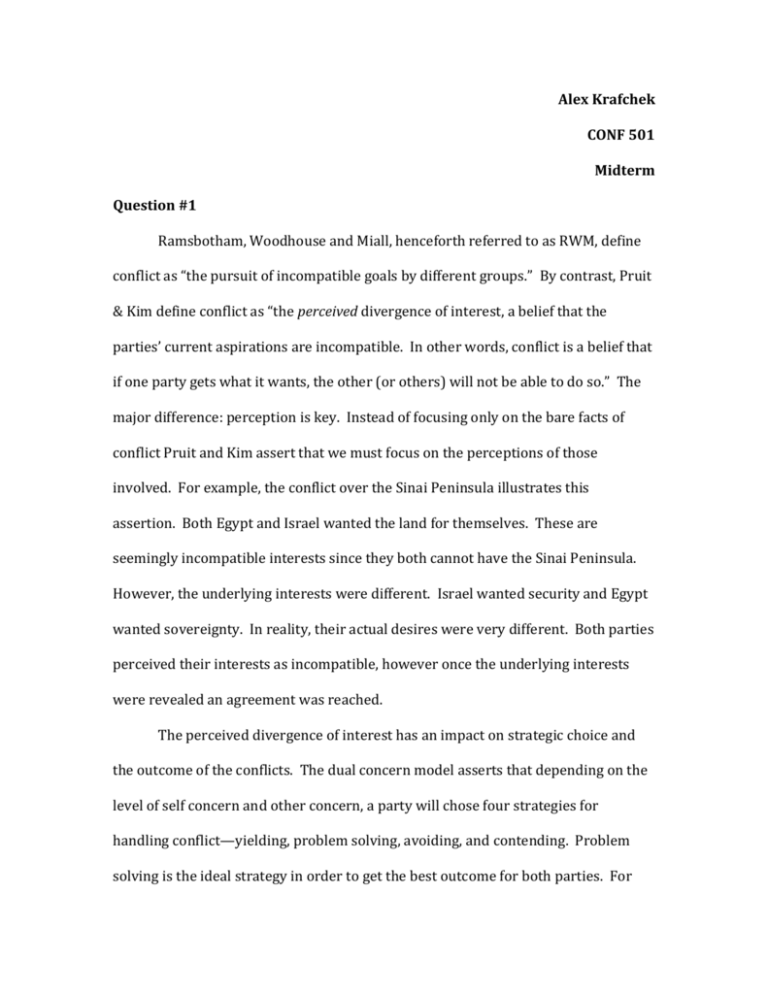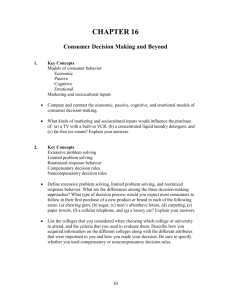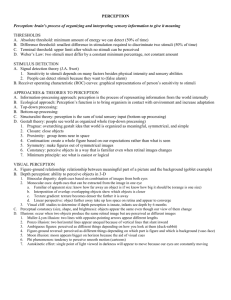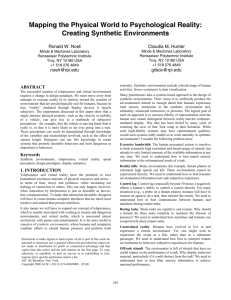Intro to Conflict Resolution Midterm
advertisement

Alex Krafchek CONF 501 Midterm Question #1 Ramsbotham, Woodhouse and Miall, henceforth referred to as RWM, define conflict as “the pursuit of incompatible goals by different groups.” By contrast, Pruit & Kim define conflict as “the perceived divergence of interest, a belief that the parties’ current aspirations are incompatible. In other words, conflict is a belief that if one party gets what it wants, the other (or others) will not be able to do so.” The major difference: perception is key. Instead of focusing only on the bare facts of conflict Pruit and Kim assert that we must focus on the perceptions of those involved. For example, the conflict over the Sinai Peninsula illustrates this assertion. Both Egypt and Israel wanted the land for themselves. These are seemingly incompatible interests since they both cannot have the Sinai Peninsula. However, the underlying interests were different. Israel wanted security and Egypt wanted sovereignty. In reality, their actual desires were very different. Both parties perceived their interests as incompatible, however once the underlying interests were revealed an agreement was reached. The perceived divergence of interest has an impact on strategic choice and the outcome of the conflicts. The dual concern model asserts that depending on the level of self concern and other concern, a party will chose four strategies for handling conflict—yielding, problem solving, avoiding, and contending. Problem solving is the ideal strategy in order to get the best outcome for both parties. For problem solving to seem like a possibility for the party, they must perceive other as being at least slightly flexible in their position. The perception of flexibility will be enhanced by Party’s trust that Other is concerned about the interests of Party. The dual concern model illustrates the preferred strategy in that conflict, but for the strategy to be put in place it must be seen as possible. Therefore, while, Both Pruit and Kim and RWM use the dual concern model, Pruit and Kim took it a step further and introduced the Perceived Feasibility Model. This model states that problem solving is more feasible the greater the perceived common ground, or PCG. As Pruit and Kim assert, “PCG is the mirror image of conflict as defined earlier. As PCG goes up, conflict, in the sense of perceived divergence of interest, goes down.” Conditions that contribute to greater PCG include: faith in their own problem-solving ability, positive-sum thinking, prior success at reaching agreements in the controversy, the perception of the other party’s readiness for problem solving and the availability of a third party. Thus, perception influences the possible intervention that could be used to solve the conflict. Referring back to the Sinai example, President Carter’s first attempts to mediate the conflict included the proposal of a compromise in which each state would receive half of the Sinai Peninsula. This intervention failed because the actual and perceived interests were not aligned. There are extensive ways for third parties to intervene including, mediation, arbitration, negotiation, sanctions and military action. As mentioned, perception of the parties involved can influence the choice of intervention. For example, if the perceived divergence of interests is high then generally speaking the degree of mistrust is also going to be high, making negotiation more difficult. Furthermore, the failure of earlier negotiations between parties can lead to very different narratives and perceptions of the reasons the negotiation failed, which would also make negotiation a poor intervention choice. The contingency approach to third party intervention outlined by Fisher and Keashley, is based on the idea that conflict includes objective and subjective elements and that different interventions are appropriate at different times. Arguably the most appropriate intervention to include to the list of interventions when dealing with a conflict with a high perceived divergence of interests would be conciliation. This allows the major issues to be identified, lowering of the tension, and most importantly, clearer communication on interests and positions. In this way, misperceptions can be addressed and hopefully lead to negotiations. From the strategies and interventions of conflict detailed above, it is clear that perception is an important factor when analyzing and helping to transform conflict. As Hopmann quoted in his article, Bargaining and Problem Solving, “People generally assume that differences between the two parties create the problem. Yet differences also lead to a solution.” Parties may perceive their interests or goals as incompatible, when in fact a win-win resolution may be possible.









